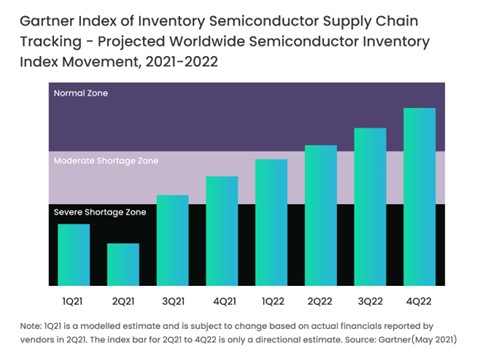Challenges Faced by Semiconductor Industry and Global Silicone Shortage
The current semiconductor shortage issue is impacting almost every business around the world. Even the most unassuming of businesses can feel the squeeze. It ranges from technology to retail and just about everything in between. The crisis we’re facing has been caused by a perfect storm of global silicon shortages (of semiconductor chips), which is undeniably the new age god even to the most agnostic soul.
semiconductor shortage solution
It is becoming increasingly important for global industries to transition from a reactive approach to a proactive one. For supply chains worldwide, this is a declaration to ion to urgently take steps to mitigate risks while improving supply chain visibility. And find a semiconductor shortage solution.
The Age of the Chip
Global Semiconductor Shortage Explained
Ask me what’s the fuss about. The proverbial ‘chip’ on the global economy’s shoulder just got heavier. Weren’t we already actively battling the several waves and the resulting aftereffects of the Corona Virus? While the Semicon chip chaos exacerbates, let's first understand why the pandemonium. What can a tiny chip do? We have the global silicone shortage explained to you.
Apparently, a lot! It powers industries, varied ones, even our everyday lives.
The silicon-based semiconductor chips are the genesis of all the sleek, fast, cheap, and efficient modern machines you see today, from smart phones to smart devices to smart equipment in a range of industries. Let’s hand it down to the chip for making us smarter, not google (not discounting the search engine’s contribution, but what would be the use of an elevator without a tall standing structure like a building). I mean yes, I can imagine an elevator in the air, but that’s leap years away.
“Silicon feeds a $500bn chip industry that in turn powers a global tech economy worth an estimated $3tn. The semiconductor business has also become one of the most interlinked in history.” BBC, Article: The humble mineral that transformed the world.
Getting to the point! The Chip has done its bit for this age. But its powers only grow exponentially as the years progress. This is not mad-brilliant-aspirational science from H.G Wells’ or Ray Bradbury. This is our future. These little folks are the most vital molecules driving the connected world; computing, telecommunications, household appliances, banking, security, healthcare, transportation, manufacturing, the list is long and unending.
The War for Infinite Chips: The semiconductor chip shortage 2022- How far will this go?
So, what’s the kryptonite here to our superchip’s spread and availability?
The chips are in short supply! As simple and vague as this answer sounds, there is a history of mammoth battles behind its present fate. And no, we can’t blame the pandemic alone for this. This situation has been developing for years, not just months, and it is strongly underlined by economic-political connotations (that’s a tale for another day).
The rise of 5G (that catapulted the demand) was one of the major reasons, among others, brewing the chip crisis (which may spill into a definite semiconductor chip shortage 2022) way before the pandemic hit us, says Koray Köse, an analyst at Gartner.
Semiconductor Shortage as Illustrated by Gartner

Besides this, a Series of Events/Practices Contributed to the Semiconductor Shortage
Our struggles with the pandemic go on (of course, nothing, I mean, nothing was not impacted by COVID-19). This period has been as much about loss as it is paradoxically about gains. A lot of segments witnessed expansion, which led to a semicon sales increase by 5-10%. What strategically happened was, our chip fellas saw that car sales during pandemic probably were down to zero (for that very pessimistic time at least), so they shifted focus to other applications and industries. But the good ole cars came back with a bang. NO ONE ANTICIPATED THAT!
Chip utilization continues to be staggeringly high (80% give or take). To match this the Semicon industry increased its manufacturing capacity by close to 180%, but that is almost getting exhausted as the demand is not going down anytime soon.
Consumer electronics choose being beefed up with Semicon chips to the alternative; facing the day when the supply is non-existent resulting from geo-political tensions. This means a large chunk of chip sales are going to them rather than automotive, who were the primary consumers.
What can semiconductor supply chain companies do now?
It’s a clear case of “not putting all your apples in one basket” with Chip manufacturers now. Instead of heavily relying on the automotive industry, they are diversifying to other industries this time with longer-term contracts.
That and a few more things like manufacturers keeping minimum stock, left the world a bit unprepared for the unfolding events. Does that mean we scatter now? How far reaching is its impact?
Does it Spell Doom for Your Industry?
Is there a Global Electronic Shortage Solution?
A global silicone shortage solution may be a distinct possibility. Demand exceeding supply is never good news (economics one-oh-one). Prices of everything even remotely related to chips increase; read: everyday appliances to cars, as the global supply chain has been severely disrupted.
The semiconductor industry is undergoing a shift in how it approaches supply chain management. Gone are the days when chip Fabricators would ship a batch of chips to a customer and then hand off the remaining chips to a Supplier. Today, semiconductor manufacturer inventory management requires multiple signs of availability on the part of Suppliers and/or Modem Programmers to be maintained appropriately onto a customer’s chip.

Since this is decidedly unprecedented in scale, affecting businesses across the value chain, primarily driven by a doubling of demand, the limited number of suppliers in today's market make it difficult for OEMs to find alternative suppliers in case one of them encounters issues with product quality or delivery times. As businesses plan their next steps, and semiconductor manufacturers struggle to keep up with the demand, both need to align their short- and long-term strategies to manage supply-chain disruption.
Guarding and Future Proofing your Supply Chains
Jade’s plan for the semiconductor shortage issue
According to a McKinsey report “Intelligence to create better transparency is a no-regrets move” as one of the most powerful supply chain strategies.
Market analysts and industry experts unanimously vote for greater transparency through supply and demand play intelligence for stronger supply chains. Let’s simplify this. Imagine this as a war room or a watch tower that gives semiconductor supply chain companies an eagle’s eye view to help you easily move over all the connected pieces of your supply chain laid open before you.
It is a highly complicated process that includes many players – far too many for anyone to keep track of every step of the supply chain. That makes supply chain management a key attribute for success – but one that is often overlooked.
For the semiconductor market, this means receiving all the real-time information you can get about your supply chain, including the Manufacturer’s commitments, Deliveries, and forecasts. Robust Supply Demand Intelligence provides managers with a single source of supply chain data that delivers instant access to critical supply chain information.
Get all information you can through automatic real-time dashboards that bring together data from multiples sources and diverse segments.
It’s not only about knowing the true demand but also getting access to complex data that allows you to differentiate between facts and assumptions, understand the price points your customers are willing to pay for your product or service, track competitor strategies which will impact supply chains. Wouldn’t you want to take advantage of a system that integrates all operations to improve your business in a context where speed is a prime value. Plus, it has now become necessary to capture insights into supply demand position in real time and proactively manage it with optimized planning and execution.
A transparent supply chain means providing the user access to industry news, order confirmation information, overbooking, trends, product launch dates & forecasts, vendor inventory, carrier contract information, and much more that will help you understand all aspects of your supply chain so you can make smarter decisions for your company and ensure business resilience.
Leveraging advanced analytics can further help you match demand with supply and do away with error-prone human intervention.
Breaking the barrier to Visibility: The Multiverse of Possibilities through Oracle Cloud Planning:
A resolution with a semiconductor shortage solution
According to a recently published report by Semiconductor Industry Association (SIA) and Boston Consulting Group (BCG),
“About 75% of semiconductor manufacturing capacity, as well as many suppliers of key materials — such as silicon wafers and other specialty chemicals — are concentrated in China and East Asia, a region significantly exposed to high seismic activity and geopolitical tensions. These are single points of failure that could be disrupted by natural disasters, infrastructure shutdowns, or internal conflicts, and may cause severe interruptions in the supply of chips.”
While the debate on reducing the dependency on the global supply chain continues, the emergence of local solid supply chains may take some time and big money. Semicon supply chains cannot wait between ‘what led’ and ‘what ifs. They need a more solid ‘can’.
Conclusion
Jade’s continuous engagement with the hi-tech Semicon industry, insight into the vulnerabilities of the supply chain, and their firm grip and expertise applying Oracle Cloud’s capabilities led to the development of a unique solution to Equip the Semicon Supply Chain for current semiconductor shortages with Oracle Cloud Planning. The solution is about ensuring better visibility and transparency and is your answer to strengthening your supply chain.ain now.
Jade Global explains the current semiconductor chip shortage scenario in the Semicon industry, how we can help you plan your supply chain better to address these problems, convert the challenges into a business benefit, and to finally build a resilience supply chain













